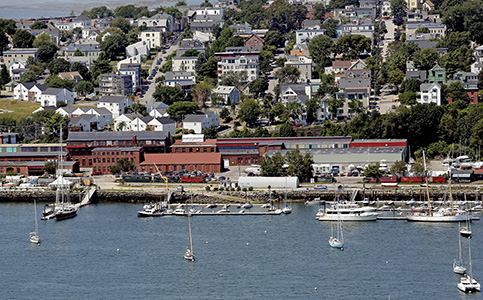Portland voters will decide Nov. 3 whether to adopt a zoning ordinance that could affect real estate development in Maine’s largest city and economic center for years to come by establishing a process to prevent new projects from blocking public views of the ocean, mountains, public parks and historic buildings.
The proposed ordinance takes aim at one waterfront project in particular: the redevelopment of the former Portland Co. complex at 58 Fore St. That plan received a zone change in June that allows taller buildings and a wide range of uses, including housing, retail and restaurants.
However, if passed by voters, the ordinance would apply retroactively to the project and alter the zoning rules approved by the Planning Board and City Council. It would prevent any new structure, such as a building or a fence, from rising more than 4 feet above 58 Fore St. Other impediments to the view, such as bright outdoor lights or tall shrubs, also would be a violation of the ordinance.
The Fore Street developers say the ordinance threatens the viability of the entire project, which is estimated to generate $200 million in economic benefits to the city.
But the potential impact of the ordinance goes well beyond one contentious project.
It would create a task force to study other distinctive views that should be protected, while allowing residents – whether it’s one affected property owner or 20 residents citywide – to petition the city for additional view protections. It would also require developers to submit detailed site plans before obtaining a zone change, which they say is an additional and unnecessary layer of review and expense.
While the complex ordinance is printed in its entirety in small type on the city ballot and might seem tedious and difficult to understand, the stakes are high. If approved, the ordinance cannot be changed for five years and, unlike other citizens initiatives, it can only be amended or repealed through a citywide referendum, not by the council.
Some potential impacts of the ordinance are not quite clear, including whether it applies only to rezoning requests and whether there is a point in the planning review process when it becomes too late to file a petition for a scenic protection overlay zone. And the ordinance does not define who qualifies as an “affected property owner” who can petition the city to protect a view.
City officials have so far not provided details about impacts or a legal interpretation of how the city would implement the ordinance.
Last week, the city’s planning director and top attorney were not available to discuss the impacts. City Hall spokeswoman Jessica Grondin said staff can only conduct a preliminary analysis of the ordinance, but did not want to offer an interpretation of its impact to insulate itself against accusations that the city was trying to sway voters.
“I’m going to have to ask that you ask the authors of the ordinance for their interpretations to answer your questions,” Grondin said. “We’re not going to get involved at this point.”
AN ISSUE ‘FOR YEARS TO COME’
One side claims that without the ordinance the city could forever lose a treasured resource, which is the view of Portland Harbor along a more than 400-foot stretch of Fore Street.
“We are against blocking that view and we are against a process that doesn’t take into account quality-of-life issues,” said Anne Rand, spokeswoman for the Save the Soul of Portland Political Action Committee.
The other side says the ordinance would have many unintended consequences, including infringing on private property rights and making it easier for small groups of residents to block developments that might address a citywide need for housing and economic development.
“It is so imprecise that you could be standing almost anywhere in the city and point to something someone might consider to be an important view and with very little effort launch this process,” said David Farmer, a leader of the Portland’s Future PAC, which opposes Question 2.
Currently, developers asking for a change in zoning limits, such as allowing specific commercial uses or taller buildings, are not required to disclose details of what they would like to develop. Rand said that devalues the process that allows the public to provide input before the Planning Board and City Council. Allowing zone changes, such as the ones granted for 58 Fore St. and across town at 101 York St., without project details sets “a very bad precedent,” Rand said.
The ordinance would require developers asking for zone changes to first submit site plans that provide details about new buildings, driveways, parking areas, walkways, and landscape and property boundaries. The plan needs to be detailed enough to assess the potential impact on views, public infrastructure and adjacent structures, among other issues.
Rezoning requests for properties of an acre or more could be required to submit even more detailed plans.
“We had nothing to react to because to this day nobody knows what will be built there,” Rand said of 58 Fore St. “The referendum fixes that.”
In addition to creating a scenic overlay zone at 58 Fore St., the proposed ordinance establishes a 13-member Scenic Viewpoint Task Force to be appointed by the mayor that would look for other views to preserve.
Those recommendations about views that deserve protection would be sent to the Planning Board and City Council for final approval – the very bodies that approved the zone change at 58 Fore St., which precipitated the referendum.
Beyond that, the ordinance creates a mechanism for one affected property owner or 20 city residents to petition the city to create a scenic overlay zone. It is not clear who would qualify as an affected resident. Opponents say that provision is just one example of how the ordinance is too broadly written and could lead to more lawsuits and citizens referendums.
“I think it’s going to pit neighbors against neighbors for years to come,” said Jess Knox, a leader of Portland’s Future.
The campaign has featured accusations that the Soul of Portland is misleading voters by exaggerating the potential impact of the proposed development.
A Sept. 29 post on the group’s Facebook page declares, “We don’t need another Portland House (an 11-story residential tower at 45 Eastern Promenade) blocking the views on the Eastern Waterfront.” The developer, however, would not be able to build a similar structure because the site is limited to a maximum of 35 feet, or three stories. Rand conceded Wednesday that was an “inaccurate portrayal,” but the post was still active Friday.
Before forming a PAC and being required to disclose financial backers, the group commissioned an architectural rendering, showing a large wall along Fore Street, which the developers said exaggerated building heights.
And while the city’s zoning also requires the protection of three 50-foot-wide view corridors overlooking the harbor at St. Lawrence, Atlantic and Waterville streets, an image posted by Save the Soul of Portland shows the view corridors as a car-length-size gap between two houses, then asks: “Sweeping views or ‘view corridors.’ In November, you’ll decide.” Another image shows a man peering through an even narrower corridor.
The group has even raised the possibility that the developer could build a Wal-Mart on the prime waterfront parcel, even though it isn’t part of the plan and it is highly unlikely such a proposal could meet other zoning requirements.
Farmer, of the Portland’s Future PAC, called those images and claims “ridiculous and deliberately misleading.”
Rand, however, defended the materials about view corridors and the Wal-Mart argument.
“I don’t believe the council knew exactly how broad that zone change was,” Rand said.
Copy the Story Link
Send questions/comments to the editors.





Success. Please wait for the page to reload. If the page does not reload within 5 seconds, please refresh the page.
Enter your email and password to access comments.
Hi, to comment on stories you must . This profile is in addition to your subscription and website login.
Already have a commenting profile? .
Invalid username/password.
Please check your email to confirm and complete your registration.
Only subscribers are eligible to post comments. Please subscribe or login first for digital access. Here’s why.
Use the form below to reset your password. When you've submitted your account email, we will send an email with a reset code.